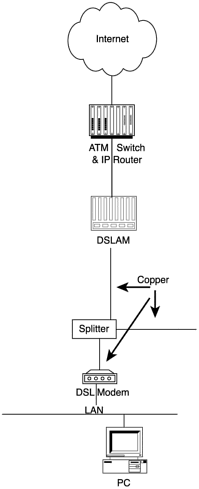Digital Subscriber Line
DSL, unlike analog services, does not provide a digital to analog conversion, but rather acts as an interface to a digital signal that is carried on the same subscriber line that provides the analog line for the telephone. While digital communications to the customer premises is common for business customers, the “last mile” to private customers has traditionally been analog; however, this is now changing with DSL. Although Asymmetric DSL (ADSL) is the most widely deployed DSL, a brief overview of some of the more common service offerings of DSL is presented as well.
High Data-Rate Digital Subscriber Line (HDSL)
HDSL is a T1 (or E1 in Europe) replacement that allows the use of copper without the necessary repeaters of T1. HDSL supports distances up to 12,000 feet. (For T1, a repeater is normally needed every 6,000 feet.) HDSL uses four wires for transmissions.
HDSL-II
HDSL-II was the next generation of HDSL and offers the same speeds as HDSL but only requires one pair of wires. A single pair of lines requires fewer connections, and single pair wires are often pre-existing in many facilities.
Single-Line Digital Subscriber Line (SDSL)
SDSL, like HDSL and HDSL-II, operates at T1 speeds; however, it only uses one pair of wires. The use of two wires does limit the distances that SDSL can function with distances ranging from 10,000 to 11,000 feet.
Asymmetric Digital Subscriber Line (ADSL)
As the name implies, ADSL does not provide the same speed in both directions as HDSL and SDSL, but rather provides a higher downstream than upstream bandwidth, which makes it ideal for Internet access where the user is downloading much more information than is being uploaded.“Uploaded” data is often simply acknowledgements to the traffic being routed downstream.
As mentioned, ADSL is the most popular form of DSL and is typically used by home and small office users. Also when DSL is mentioned, most consumers are usually referring to ADSL.
ADSL provides bandwidth up to 8.44Mbps with a distance of up to 9,000 feet. Speed offerings, however, vary by service providers and are not uniformly deployed.
Figure 12.6 shows how ADSL is offered by most service providers. An examination of the various elements that make up an ADSL deployment are covered next.
Figure 12.6. Typical ADSL offering.

The DSL Modem
The DSL modem is located at the subscriber’s location—typically the residence—and is referred to as customer premises equipment (CPE) by telecommunications technicians. The DSL modem provides a LAN interface that provides a 10Mbps Ethernet connection and a WAN interface that is connected to the splitter, which has split the lower 4khz off to the telephone.
The Digital Subscriber Line Access Multiplexer (DSLAM)
The DSLAM multiplexes the signals from the various DSL subscribers onto the provider’s network. Current generation of DSLAMs provide an Asynchronous Transfer Mode (ATM) interface to the service provider’s network. Early implementations were typically frame relay interfaces (covered later). Some DSL proponents expect IP to become the interface of choice in next generation DSLAMS, but market reality and current deployments will likely encourage vendors to provide multiple interfaces and let the service provider choose.
